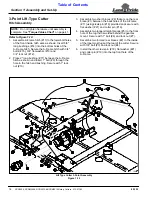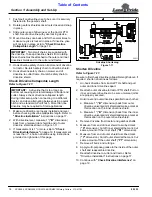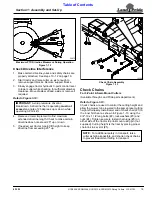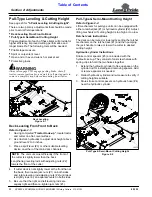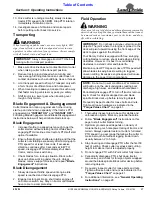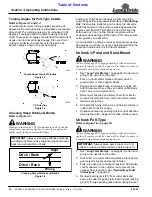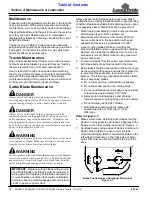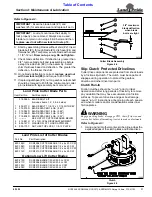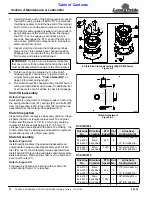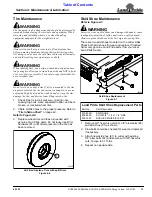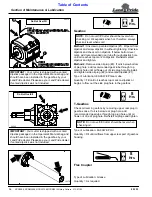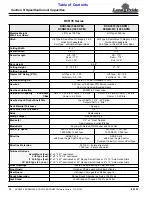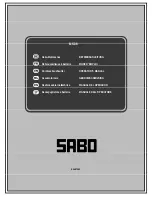
23
Section 2: Adjustments
8/15/12
RCR3596, RCRM3596, RCR3510 & RCRM3510 Rotary Cutters 312-517M
Table of Contents
3-Point Leveling & Cutting Height
See page 22 for "Pull-Type Leveling & Cutting Height".
There are four primary adjustments for the 3-point Rotary
Cutter that should be made prior to actual field
operations:
•
Deck Leveling From Left to Right
•
Deck Leveling From Front to Rear
•
Center Link Adjustment
•
Tailwheel Height Adjustment
Proper adjustment of each of these items will provide for
higher efficiency, improved cutting performance and
longer blade life. The following tools will be needed:
•
Pliable tape measure
•
Spirit or carpenter’s level
•
Open end or hex end wrench or socket set
•
Protective gloves
!
WARNING
Always disengage PTO, engage parking brake, shut off
tractor, remove ignition key, and wait for all moving parts to
come to a complete stop before dismounting from tractor.
Deck Leveling
Figure 2-3
Deck Leveling From Left to Right
Refer to Figure 2-3:
Rotary Cutter must operate level from side to side at all
times. Make certain gauge wheels are adjusted to
identical heights before adjusting lower 3-Point lift arms.
1.
Locate tractor and cutter on a flat level surface.
2.
Use tractor’s hydraulic 3-point control lever to lower
cutter until tailwheels make contact with the ground.
3.
Place a spirit level or other suitable leveling device on
the front of the cutter deck.
4.
Adjust either one or both of the tractor’s lower 3-Point
lift arms to level the deck from left to right. Some
tractors have only a single adjusting lift arm.
16267
Deck Leveling From Front to Rear
Refer to Figure 2-4:
!
CAUTION
Avoid direct contact with cutter blades by wearing a pair of
gloves. Cutter blades have sharp edges and burrs that can
cause injuries.
1.
Using tractor’s 3-point hydraulic control, raise or
lower 3-point arms until front of deck is slightly lower
than deck rear.
2.
The top center link should be loose when deck rear is
supported by the tailwheel. If not, lengthen center
link until loose. Final adjustment will be made later.
3.
With gloves on, carefully rotate each blade tip to the
position shown in Figure 2-4.
4.
Measure distance from cutting tip of blade to ground
surface. This distance is the cutting height.
5.
If desired cutting height cannot be obtained by
adjusting the lower 3-point arms, then readjust
tailwheel height. See “Tailwheel Height
Adjustment” on page 24.
6.
Repeat steps 1 to 5 until desired cutting height is
achieved.
7.
Set tractor’s 3-point control stop at this height.
Cutting Height
Figure 2-4
Center Link Adjustment
Refer to Figure 2-4:
1.
Lower cutter deck to the nominal cutting height.
2.
Adjust the top center 3-Point link until the cutter hitch
pin is vertically above the lower lift arm hitch pins.
3.
Lock center link in this position once correct length is
achieved.
IMPORTANT: The front blade tip should be lower
than the rear blade tip. If front and rear blades are
the same height or if rear blade is lower, then the
cutter is subject to continuous material flow under
the deck resulting in horsepower loss, grass clumps,
high blade wear, and frequent blade sharpening.
22316
Front Blade Tip
Rear Blade Tip
Vertical Alignment








